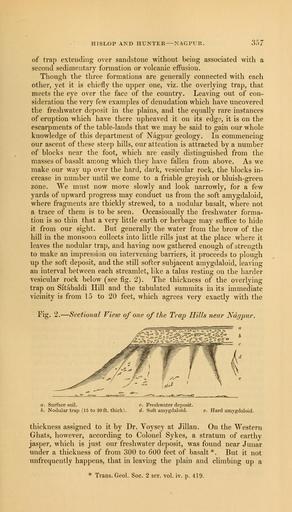MAKE A MEME
View Large Image

| View Original: | The_Quarterly_journal_of_the_Geological_Society_of_London_(12711967564).jpg (1828x3200) | |||
| Download: | Original | Medium | Small | Thumb |
| Courtesy of: | commons.wikimedia.org | More Like This | ||
| Keywords: The Quarterly journal of the Geological Society of London (12711967564).jpg HISLOP AND HUNTER NAGPUR 357 <br> of trap extending over sandstone without being associated with a <br> second sedimentary formation or volcanic effusion <br> Though the three formations are generally connected with each <br> other yet it is chiefly the upper one viz the overlying trap that <br> meets the eye over the face of the country Leaving out of con- <br> sideration the very few examples of denudation which have uncovered <br> the freshwater deposit in the plains and the equally rare instances <br> of eruption which have there upheaved it on its edge it is on the <br> escarpments of the table-lands that we may be said to gain our whole <br> knowledge of this department of Nagpur geology In commencing <br> our ascent of these steep hills our attention is attracted by a number <br> of blocks near the foot which are easily distinguished from the <br> masses of basalt among which they have fallen from above As we <br> make our way up over the hard dark vesicular rock the blocks in- <br> crease in number until we come to a friable greyish or bluish-green <br> zone We must now move slowly and look narrowly for a few <br> 5 ards of upward progress may conduct us from the soft amygdaloid <br> where fragments are thickly strewed to a nodular basalt where not <br> a trace of them is to be seen Occasionally the freshwater forma- <br> tion is so thin that a very little earth or herbage may suffice to hide <br> it from our sight But generally the water from the brow of the <br> hill in the monsoon collects into little rills just at the place where it <br> leaves the nodular trap and having now gathered enough of strength <br> to make an impression on intervening barriers it proceeds to plough <br> up the soft deposit and the still softer subjacent amygdaloid leaving <br> an interval between each streamlet like a talus resting on the harder <br> vesicular rock below see fig 2 The thickness of the overlying <br> trap on Sitabaldi Hill and the tabulated summits in its immediate <br> vicinity is from 15 to 20 feet which agrees very exactly with the <br> Fig 2 Sectional View of one of the Trap Hills near Nagpur <br> a Surface soil c Freshwater deposit <br> b Nodular trap 15 to 20ft thick d Soft amygdaloid e Hard amygdaloid <br> thickness assigned to it by Dr Voysey at Jillan On the Western <br> Ghats however according to Colonel Sykes a stratum of earthy <br> jasper which is just our freshwater deposit was found near Junar <br> under a thickness of from 300 to 600 feet of basalt But it not <br> unfrequently happens that in leaving the plain and climbing up a <br> Trans Geol Soc 2 ser vol iv p 419 35614945 110213 51125 Page 357 Text v 11 http //www biodiversitylibrary org/page/35614945 1855 Geological Society of London Biodiversity Heritage Library The Quarterly journal of the Geological Society of London v 11 1855 Geology Periodicals Smithsonian Libraries bhl page 35614945 dc identifier http //biodiversitylibrary org/page/35614945 smithsonian libraries Information field Flickr posted date ISOdate 2014-02-23 Check categories 2015 August 26 CC-BY-2 0 BioDivLibrary https //flickr com/photos/61021753 N02/12711967564 2015-08-26 20 58 55 cc-by-2 0 PD-old-70-1923 The Quarterly journal of the Geological Society of London 1855 Photos uploaded from Flickr by FĂŚ using a script | ||||